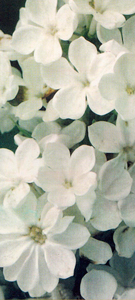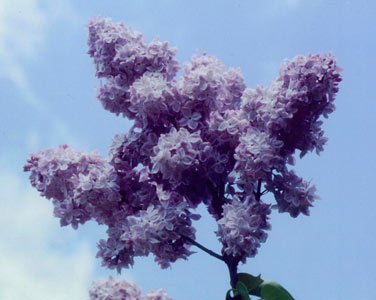ABOUT SYRINGA PLUS • LILAC CARE • NOTABLE LILACS • RELATED LINKS • RECOMMENDED NURSERIES • SYRINGA PLUS SAMPLE ROOT SYSTEMS
Notable Lilacs – A compendium of old friends!
This section contains information about individual cultivars of lilacs, including their breeders and provenance.
Syringa vulgaris ‘Frederick Law Olmsted’
A Richard Fennichia introduction, 1996.
{‘Rochester’ × ‘Rochester’}
Single white.
A Fennichia hybrid with ‘Rochester’ parentage. It has the ability to produce a well-rounded plant when given enough space. The mature plant (20 years old) is small to medium size, 8’ – 9’ high and 7’ – 8’ wide.
The exceptional feature of ‘Frederick Law Olmsted’ is that it annually produces clusters of pure white flowers that are evenly distributed over the whole plant, giving it a “snowball effect,” to use the hybridizer’s own words. It displays good green foliage throughout the summer. ‘Frederick Law Olmsted’ has one drawback: the florets do not display the prominent radial doubling of other ‘Rochester’ hybrids.
Photo courtesy of R. E.Hoepfl
Syringa ‘Red Pixie’
Hybridized by Max Peterson of Ogallala, Nebraska.
{S. meyeri var. meyeri × S. pubescens subs. julianae ‘Hers’}
Red Pixie is one seedling selected out of eight germinated from a pod of S. julianae ‘Hers’. The other seven seedlings appeared to be straight ‘Hers’.
It has the appearance of S. meyeri but the flowers are similar to S. julianae. However, ‘Red Pixie’ branches grow more horizontally, like those of ‘Hers’. The leaves are slightly larger than S. meyeri and slightly more pointed.
It matures to about 5 feet high and about 4 feet wide. Some years, the leaves have a reddish tinge along the edge. The blossom is single and similar to S. julianae . It opens ruby red and gradually fades to a light pink.
Syringa vulgaris ‘Sesquicentennial’
A Richard Fenicchia selection.
{‘Rochester’ × ‘Glory’}. Single violet (class II).
This Fenicchia hybrid displays large one-inch violet-lilac florets. Generally a very strong-growing shrub, suckering slightly. Many flower panicles are produced from lateral buds along the stem, making a tremendous display. This habit tends to make the flower-heavy stems bend under their own weight.
‘Sesquicentennial’ occasionally displays ‘Rochester’ multipetalling. Flowers with heavy fragrance. This lilac was named for the 150th anniversary of Monroe County, New York, the governing agency of Highland Park.
A Richard Fenicchia selection 1972; registered in 1988.
Photo courtesy of © Max Peterson
Syringa vulgaris ‘Atheline Wilbur’
A Father Fiala hybrid, 1980.
{(‘Rochester’ × ‘Edward J. Gardner’) × ‘Rochester’}.
Double magenta.
‘Atheline Wilbur’ is an exceptional lilac. The unique double blooms are very hard to describe. Individual florets open irregularly, giving a multicolored appearance to the entire bloom. The large clusters contain unopened buds and fully opened florets, showing a combination of rose, orchid, and lavender. Fragrant.
‘Atheline Wilbur’ was hybridized by Father Fiala prior to 1980. It was named “to honor a lovely lady who cherished lilacs.” It was registered by Charles Tubesing of the Holden Arboretum in 1999.
Syringa oblata ‘Betsy Ross
A U.S. National Arboretum introduction, 2000.
{? × S. oblata}
Single white.
‘Betsy Ross’ is the first lilac cultivar to be released by the U.S. National Arboretum. It is an early-blooming lilac, well adapted to warmer climates and having good field tolerance to powdery mildew. ‘Betsy Ross’ was selected for its abundant, white, fragrant flowers and compact, rounded growth habit.
‘Betsy Ross’ is the product of a lilac hybridization program initiated in the early 1970’s by the late Dr. Donald Egolf to develop superior, disease-tolerant lilacs for warmer climates. ‘Betsy Ross’ originated from a cross made in 1977 using Syringa oblata collected in China as the male parent and an unidentified Syringa from Highland Park, Rochester, NY, as the female parent.
It was named by Dr. Margaret Pooler after Betsy Ross [1752-1836], who sewed the first American flag.
Please stay tuned for the U.S. National Arboretum to release two more lilacs as part of their series of three lilac introductions.
Syringa vulgaris ‘Edith Cavell’
Introduced by Lemoine, 1916.
Double white.
‘Edith Cavell’ is a beautiful, mid-season blooming white lilac. The double flowers are very fragrant. ‘Edith Cavell’ has large, heart-shaped leaves that are very dark in color. It is one of most vigorous-growing white lilacs. The plant grows to 8’ – 10’ tall by 4’ – 5’ wide.
Lemoine named ‘Edith Cavell’ after Edith Louisa Cavell [1865-1915], a British army nurse executed by the German military during World War I. She was Matron of the Berkendael Institute in Brussels. When Brussels fell to the Germans, Cavell was allowed to stay on. Regardless of nationality, Edith provided the best treatment she could to the injured.
During this time, Cavell had been using the hospital to help Allied escapees avoid the German forces. She was caught, and made a full confession. She was then sentenced to death by firing squad. She was executed on October 12th, 1915.
Syringa vulgaris ‘Alvan R. Grant’
Registered by Richard Fenicchia, 1995.
{‘Rochester’ × ‘Madame Charles Souchet’}
Single purple.
A Fenicchia selection named in honor of the man responsible for the ‘Rochester’ lilac. The mature plant (20 years old) is a medium-sized shrub 8 to 10 feet high with an equal spread.
The large, single purple florets display distinctly curved petals. As the florets open, the backside of the petals fade to reveal a silvery cast.
The flowers generally appear on top of the foliage so as to attract attention. The lack of suckering ability reflects its ‘Rochester’ parentage.Fiala Hybrids.
Fiala Hybrids
Syringa ×chinensis ‘Lilac Sunday’
An Arnold Arboretum introduction, 1997.
Single purple.
Introduced in 1997 by the Arnold Arboretum, named in honor of the Arboretum’s annual celebration of Lilacs.
The flowers of ‘Lilac Sunday’ are a fragrant, single, light purple and produce an abundant display of cascading blossoms every year, coinciding with the earlier cultivars of the common lilac.
Although each individual flower is small, the flower panicles are produced not only at the branch tips, like the common lilac, but also from the lateral buds along the stems at a distance of two or more feet from the branch tips.
A small-leaved lilac, the branches themselves are willowy, arching under the weight of the flowers and giving the impression of being two feet long. ‘Lilac Sunday’ should attain a size of about 10’ high x 12’ wide.
Disease resistant and hardy to Zone 3.
To quote Jack Alexander, Plant Propagator of the Arnold Arboretum, “Lilac cultivars may be selected for fragrance, color, and abundance of flower. ‘Lilac Sunday’ was chosen for all these traits but even more for its very attractive habit.”
S. v.‘ Frank’s Fancy’
A Weston Nurseries introduction, 1991.
{‘Sensation’ × ?}
Single purple.
‘Frank’s Fancy’ was introduced by Weston Nurseries, Inc. in 1991. An open-pollinated seedling, with ‘Sensation’ as the seed parent.
The seedling was named ‘Frank’s Fancy’ after Frank Goodwin, a personal friend of Edward Mezitt, of Weston Nurseries, Inc. On seeing the lilac, Frank exclaimed, “That’s the prettiest dark purple lilac I ever saw!”
A single, dark purple lilac. A vigorous grower.
Richard Fenicchia Hybrids
Richard Fenicchia hybrids using Syringa vulgaris ‘Rochester’ as a parent. Many of his cultivars display Rochester’s multi-petaling.
|
|
 Single/Multi-petaled Blue.
|
|
|
|
 S. v. ‘Flower City’ S. v. ‘Flower City’Single/Multi-petaled Violet-Purple |
 S. v. ‘Alvan R. Grant’ S. v. ‘Alvan R. Grant’Single Purple |
|
|
|
|
ABOUT SYRINGA PLUS • LILAC CARE • NOTABLE LILACS • RELATED LINKS • RECOMMENDED NURSERIES • SYRINGA PLUS SAMPLE ROOT SYSTEMS











 S. v. ‘Rochester’
S. v. ‘Rochester’ S. v. ‘Frederick Law Olmsted’
S. v. ‘Frederick Law Olmsted’ S. v. ‘Charles Lindbergh’
S. v. ‘Charles Lindbergh’ S. v. ‘Frederick Douglass’
S. v. ‘Frederick Douglass’ S. v. ‘Margaret Fenicchia’
S. v. ‘Margaret Fenicchia’ S. v. ‘Sesquicentennial’
S. v. ‘Sesquicentennial’